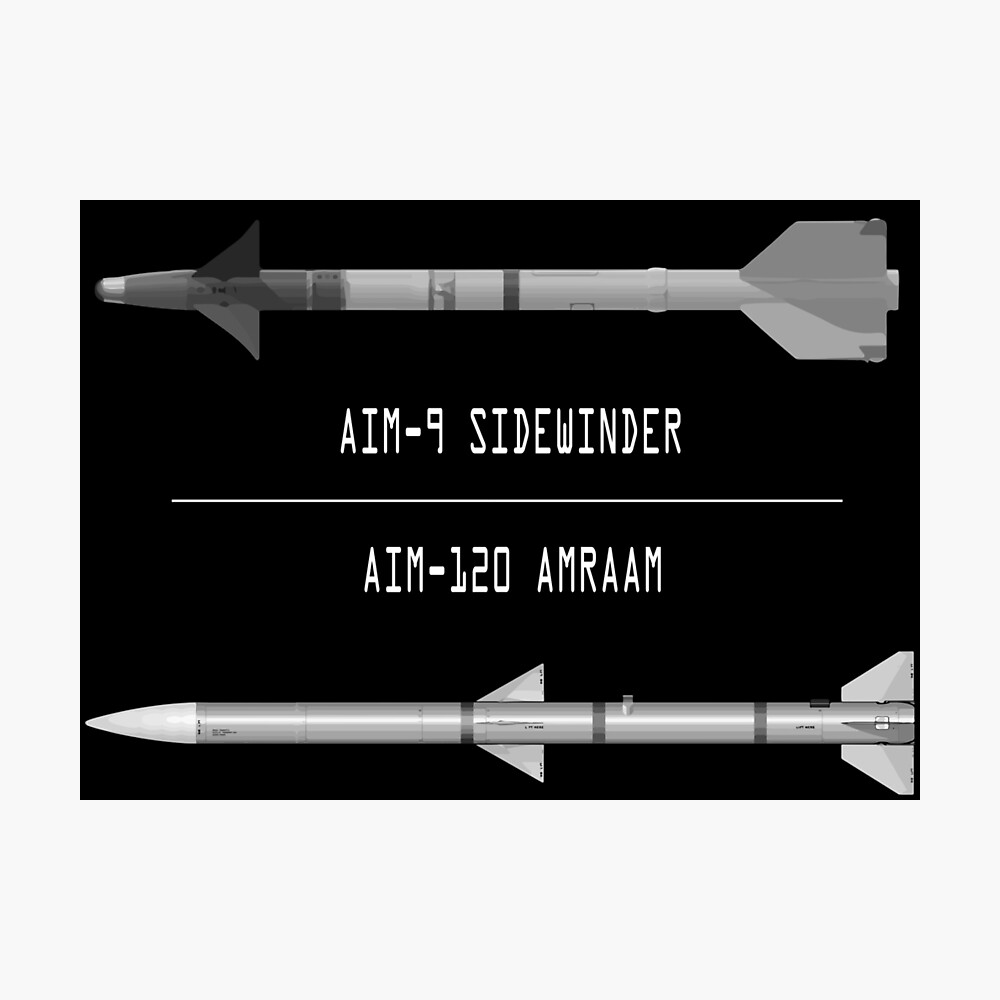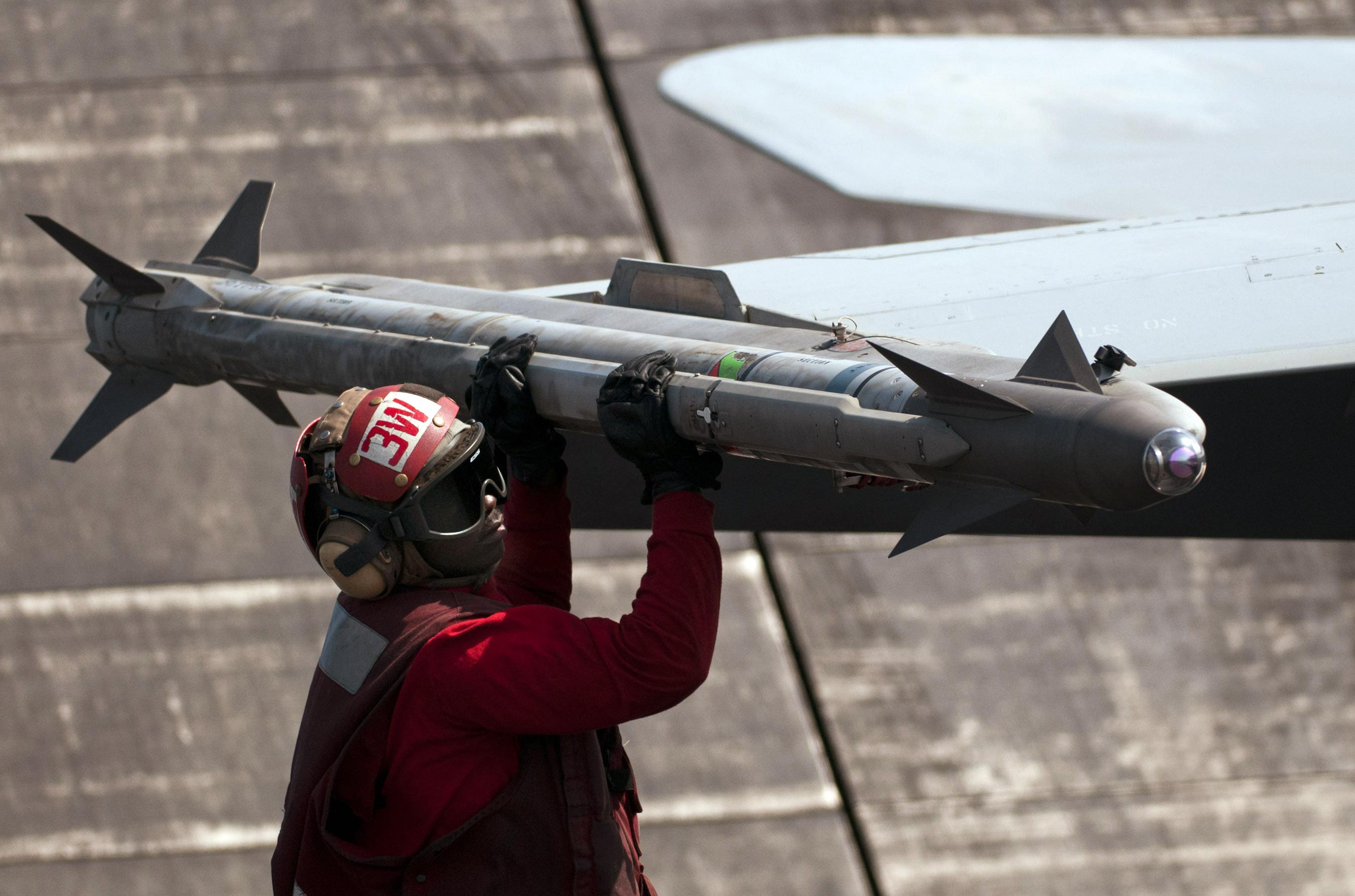Amraam Vs Sidewinder - The AIM-9 Sidewinder missile ("AIM" stands for "Air Intercept Missile") is a short-range air-to-air missile that entered service with the US Navy in 1956, then was adopted by the US Air Force in 1964. As the Sidewinder has proven to be an international success, its latest variant remains standard equipment in most Western air forces.
The Soviet K-13 (AA-2 "Atoll") was an inverted replica of the AIM-9B, also widely used by many countries.
Amraam Vs Sidewinder

Low-level development began in the late 1940s and emerged in the early 1950s as a guidance system for the Zuni modular rocket.
The U.s.'s New Missile Will Take On Russian And Chinese Fighters
This modularity allowed for the introduction of newer seekers and rocket motors, including the AIM-9C variant, which uses semi-active radar guidance and serves as the basis for the AGM-122 anti-radar sidewall missile. Early models started out as a rear tracking system that was used extensively during the Vietnam War with little success. This resulted in the versatile capabilities of the L version, which proved to be an extremely effective weapon during the Falklands War and Operation Mole Cricket 19 ("Bekaa Valley Turkey Shoot") in Lebanon. Its adaptability allows it to serve in newer designs such as the AIM-95 Agile and SRAAM that are intended to replace it.
The Sidewinder is the most widely used air-to-air missile in the West, with over 110,000 missiles produced for the United States and 27 other countries, of which about 1% were used in combat. It was built under license in many other countries, including Sweden, and could be fitted to helicopters such as the Bell AH-1Z Viper. The AIM-9 is one of the oldest, cheapest and most successful air-to-air missiles, with approximately 270 aircraft shot down in its history of service.
In 2002, the US Navy celebrated the 50th anniversary of the Sidewinder. Boeing won a contract in March 2010 to support Operation Sidewinder until 2055, keeping the weapon system operational until at least that date. Air Force spokeswoman Stephanie Powell noted that due to its relatively low cost, versatility and reliability, "The Sidewinder is likely to remain in service with the Air Force well into the 21st century."
The rattlesnakes were guided not by the actual position recorded by the probe, but by the change in position since the last sighting. So if the target stays 5 degrees between mirror rotations, the electronics will not send any signal to the control system. Consider a projectile fired at right angles to the target; if the bullet is traveling at the same speed as the target, it should "guide" the target 45 degrees, flying to the point of impact far ahead of where the target was fired. If the bullet is traveling four times faster than the target, it should be traveling at an angle of about 11 degrees forward. In both cases, the bullet should maintain this angle until intercepted, meaning that the angle between the target and the detector is constant. This is a fixed angle that the Sidewinder tries to maintain. This "proportional pursuit" system is very easy to implement, provides high-performance look-ahead calculations for almost free, and can respond to changes in the target's flight path,
This Pilot Scored Both The First U.s. F 16 Kill And The First Kill For The Aim 120 Amraam
During World War II, various researchers in Germany designed various complex infrared guidance systems. The most famous of them, code-named Hamburg, was the Blohm & Voss BV 143 gliding bomb, designed for anti-ship missions. Hamburg uses a single infrared photocell as a detector and a rotating disc with lines drawn on it, also known as a "grid" or "chopper". The sight rotates at a constant speed, interrupting the output of the photocells in a predetermined manner, and the exact time of the received signal indicates the target bearing. Although similar installations such as Hamburg and Madrid were largely completed, no work was done to pair them with missiles until the end of the war.
In the post-war era that had just ended, Allied military intelligence groups collected this information along with the many engineers who worked on these projects. Several extensive reports on various systems were developed and disseminated by Western aerospace companies, while several engineers joined the companies to work on various missile programs. In the late 1940s, a variety of missile programs were underway, ranging from large systems such as the Bell Bomi rocket-propelled bomber to smaller systems such as air-to-air missiles. In the early 1950s, both the U.S. Air Force and the Royal Air Force began major infrared-seeking missile programs.
Development of the Sidewinder began in 1946 at the Naval Ordnance Test Station (NOTS) in Inyorkane, California, now China Lake Naval Air Weapons Station, as an internal research project developed by William B. McLean. McLean originally named his work "Local Fuze Project 602", using lab funds, volunteer assistance, and fuze funds to develop what they called a thermal homing rocket. The name Sidewinder, chosen in 1950, is the common name for the rattlesnake Crotalus cerastes, which uses its infrared organs to hunt warm-blooded prey.

He did not receive official funding until 1951, when the work was mature enough to be presented to Admiral William "Dick" Parsons, Assistant Director of the Bureau of Ordnance (BuOrd). It was then designated as a plan in 1952. Originally known as Sidewinder 1, the first live fire occurred on September 3, 1952. The missile first intercepted a drone on September 11, 1953. The missile made 51 guided flights in 1954 and was approved for production in 1955.
An Aviation Ordinanceman Wheels Aim 9 Sidewinder Air To Air Missiles Into Place Alongside Aim 120 Amraam Air To Air Intercept Missiles (c) And Agm 88 Harm Air To Ground Missiles On The Flight Deck Of The Uss Kitty Hawk In
In 1954, the USAF tested the original AIM-9A and the improved AIM-9B at the Holloman Air Force Development Center. In mid-1956, the United States Navy's Grumman F9F-8 Cougar and FJ-3 Fury missiles entered service for the first time.
Nearly 100,000 of the first generation Sidewinders (AIM-9B/C/D/E) were built with Raytheon and Gerald Electric as major subcontractors. Philco-Ford produced the guidance and control part of the early missiles. The NATO version of the first generation rocket was manufactured by Bodseewerk Gerätetechnik under a German license, 9,200 were produced.
The Sidewinder's first combat use was on 24 September 1958 by the Republic of China (Taiwan) Air Force during the Second Taiwan Strait Crisis. During this time, the ROCAF North American F-86 Sabers regularly engaged in dogfights against the People's Republic of China in the Taiwan Strait. The PRC MiG-17 has the ability to climb the ceiling at higher altitudes and is similar to the Korean War tokens between the F-86 and earlier MiG-15s, PRC formations circle over the ROC Sabers, unaffected by their .50 caliber guns, they only choose combat conditions in their favor.
In a top-secret operation, the U.S. delivered dozens of Sidewinder aircraft to Republic of China forces and the U.S. Marine Corps Air Ordnance Corps to modify their aircraft to carry them. During the first counterattack on September 24, 1958, Sidewinders were used to ambush MiG-17s flying past the Sabers, thinking they were invulnerable. MiG broke formation and descended to Saber height in a ring fight. The operation marked the first successful use of air-to-air missiles in combat, and the downed MiG was their first casualty.
A Bomb Transporter Is Loaded With Aim 9m Sidewinder Missiles And Aim 120 Amraam (advanced Medium Range Air To Air Missiles). They Will Be Loaded Into An F 15e Eagle At Aviano Air Base On 21 February
During the 1958 Taiwan Strait Campaign, a ROCAF AIM-9B hit a PLAAF MiG-17 without exploding; the missile lodged in the MiG's fuselage and the pilot was able to bring the aircraft and missile back to base. Soviet engineers later said that the captured Sidewinder served as a "university course" in missile design, significantly improving Soviet air-to-air capabilities.
They were able to reproduce a copy of the Sidewinder that was manufactured as the Vympel K-13/R-3S missile with the NATO reporting designation AA-2 Atoll. In 1960, the Vympel K-13 entered service with the Soviet Air Force.
The war period was not as satisfactory as expected. Both the U.S. Navy and U.S. Air Force study the performance of their aircrew, aircraft, weapons, training and support infrastructure. The United States Air Force conducted the secret Red Baron Report, while the Navy conducted a study, informally known as the "Ault Report", mainly on the performance of air-to-air weapons. The impact of these two studies led to modifications to the Sidewinder by both services to improve its performance and reliability in demanding air-to-air areas.

AIM-9L training missile, part/part blue, with inert warhead and rocket motor, for training purposes.
East Vs West: An Assessment Of The Ongoing Air To Air Missile Cold War
The next major advance in IR Sidewinder development was the AIM-9L ("Lima") model, which entered full production in 1977.
It was the first "omni-directional" Sidewinder capable of attacking from all directions, including from the front, which had a huge impact on close combat tactics. It was first used by two US Navy F-14s in the Gulf of Sidra in 1981 against two Libyan Sukhoi Su-22s, both of which were destroyed by the AIM-9L. Its first use in a large-scale conflict was
Aim 120d amraam, amraam model rocket, aim 120b amraam, raytheon amraam, aim 120c amraam, f 22 amraam, amraam missile, aim 120 amraam, amraam rocket, amraam range, sidewinder, amraam
0 Comments